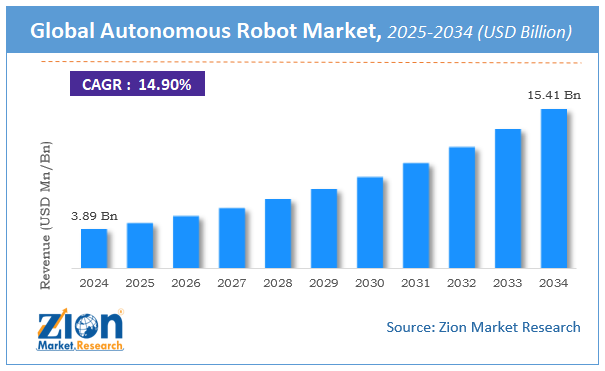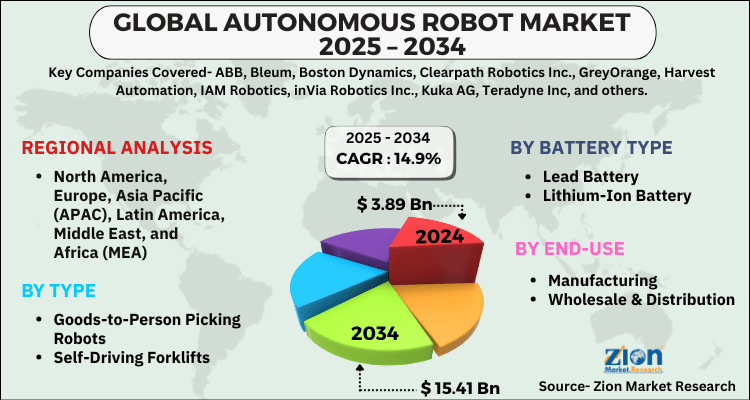Global Autonomous Robot Market Size, Share, Growth Analysis Report - Forecast 2034

Autonomous Robot Market By Type (Goods-to-Person Picking Robots, Self-Driving Forklifts, Autonomous Inventory Robots, and Unmanned Aerial Vehicles), By Battery (Lead batteries, Lithium-Ion batteries, Nickel-based batteries, and Others), End-use (Manufacturing (Automotive, Aerospace, Electronics, Chemical, Pharmaceuticals, Plastics, Defense, FMCG, Others), Wholesale & Distribution (E-commerce, Retail Chains/Conveyance Stores, and Others)), and By Region: Global and Regional Industry Overview, Market Intelligence, Comprehensive Analysis, Historical Data, and Forecasts 2025 - 2034
| Market Size in 2024 | Market Forecast in 2034 | CAGR (in %) | Base Year |
|---|---|---|---|
| USD 3.89 Billion | USD 15.41 Billion | 14.9% | 2024 |
Autonomous Robot Market: Industry Perspective
The global autonomous robot market size was worth around USD 3.89 Billion in 2024 and is predicted to grow to around USD 15.41 Billion by 2034 with a compound annual growth rate (CAGR) of roughly 14.9% between 2025 and 2034. The report analyzes the global autonomous robot market's drivers, restraints/challenges, and the effect they have on the demands during the projection period. In addition, the report explores emerging opportunities in the autonomous robot industry.
Autonomous Robot Market: Overview
Autonomous mobile robots (AMRs) are utilized in manufacturing and distribution facilities to pick, move, and sort things without the need for human intervention. One of the primary factors projected to drive market expansion is the increasing use of robots in various industrial sectors. Technological advancement, expanding application areas for autonomous robots, and increased awareness about the benefits of autonomous robots in emerging economies are some of the reasons expected to drive market expansion. In addition, the government's implementation of tough telematics laws is helping to fuel industry growth.
The rising demand for smart gadgets in automobiles, as well as the spread of advanced driver assistance systems, are driving market expansion. Moreover, the demand for incident notifications and real-time traffic is putting a favorable spin on market growth. Furthermore, as the average per capita wealth of persons rises, automated systems and infotainment services in vehicles become an increasingly important aspect of the vehicle. People expect their digital lifestyle to be translated into the car and with the help of Internet of Things automotive technologies. This is projected to boost the growth of the Autonomous Mobile Robot Market.
Key Insights
- As per the analysis shared by our research analyst, the global autonomous robot market is estimated to grow annually at a CAGR of around 14.9% over the forecast period (2025-2034).
- Regarding revenue, the global autonomous robot market size was valued at around USD 3.89 Billion in 2024 and is projected to reach USD 15.41 Billion by 2034.
- The autonomous robot market is projected to grow at a significant rate due to rising adoption in manufacturing, logistics, healthcare, and defense sectors due to advancements in ai, iot, and automation technologies.
- Based on Type, the Goods-to-Person Picking Robots segment is expected to lead the global market.
- On the basis of Battery, the Lead batteries segment is growing at a high rate and will continue to dominate the global market.
- Based on the End-use, the Manufacturing (Automotive segment is projected to swipe the largest market share.
- By Wholesale & Distribution, the E-commerce segment is expected to dominate the global market.
- Based on region, Asia-Pacific is predicted to dominate the global market during the forecast period.
Autonomous Robot Market: Driver
The exponential growth of the E-commerce business allows warehouse and distribution center owners to focus on improving their operational workflow from manual to automated to satisfy the changing purchasing behaviors of consumers. For example, Walmart Inc. began adding automated bot-staffed warehouses to dozens of its store locations for pickup and delivery in January 2021. It provides more efficiency, faster fulfillment, and increased client availability.
Furthermore, factors such as increased warehouse automation and expanding acceptance of these robots across a variety of industries, owing to their capacity to maneuver autonomously in dynamic situations, are projected to drive market expansion. Furthermore, the rising use of automated material handling, as well as trends such as lights-out automation, are likely to drive market expansion during the forecast period.
Autonomous Robot Market: Restraint
The limiting factor noted is the large initial expenditure required to develop automated distribution stores and centers in order to achieve optimal productivity and efficiency. Due to low industrial output and long-delayed return on investment ratios, this creates a difficult condition for small and medium-sized businesses to park capital. High procurement, integration, programming, and accessory expenses, among other things, are stifling global market growth. Furthermore, the providers must deploy the robots concurrently with their current operations, which might cause issues with inventory management and controls. As a result of these issues, the market is constrained.
Autonomous Robot Market: Segmentation Analysis
The global autonomous robot market is segmented based on Type, Battery, End-use, Wholesale & Distribution, and region.
Based on Type, the global autonomous robot market is divided into Goods-to-Person Picking Robots, Self-Driving Forklifts, Autonomous Inventory Robots, and Unmanned Aerial Vehicles.
On the basis of Battery, the global autonomous robot market is bifurcated into Lead batteries, Lithium-Ion batteries, Nickel-based batteries, and Others.
By End-use, the global autonomous robot market is split into Manufacturing (Automotive, Aerospace, Electronics, Chemical, Pharmaceuticals, Plastics, Defense, FMCG, Others.
In terms of Wholesale & Distribution, the global autonomous robot market is categorized into E-commerce, Retail Chains/Conveyance Stores, and Others).
Autonomous Robot Market: Report Scope
| Report Attributes | Report Details |
|---|---|
| Report Name | Autonomous Robot Market |
| Market Size in 2024 | USD 3.89 Billion |
| Market Forecast in 2034 | USD 15.41 Billion |
| Growth Rate | CAGR of 14.9% |
| Number of Pages | 188 |
| Key Companies Covered | ABB, Bleum, Boston Dynamics, Clearpath Robotics Inc., GreyOrange, Harvest Automation, IAM Robotics, inVia Robotics Inc., Kuka AG, Teradyne Inc, and others. |
| Segments Covered | By Type, By Battery, By End-use, By Wholesale & Distribution, and By Region |
| Regions Covered | North America, Europe, Asia Pacific (APAC), Latin America, The Middle East and Africa (MEA) |
| Base Year | 2024 |
| Historical Year | 2020 to 2023 |
| Forecast Year | 2025 - 2034 |
| Customization Scope | Avail customized purchase options to meet your exact research needs. Request For Customization |
Autonomous Robot Market: Regional Landscape
North America dominates the autonomous robot market as a result of rising E-commerce sales in the region. Furthermore, fast technological adoption, the presence of significant manufacturers operating in this region, and massive spending from regulatory agencies to create automated warehouses and distribution centers all contribute to the market's growth. Additionally, huge investments by governmental entities to encourage the establishment of smart factories and Industry 4.0 are key factors driving the global market.
In the coming years, the Asia Pacific is predicted to increase dramatically. This is mostly owing to the presence of approved and unauthorized regional players implementing various marketing methods to further increase its geographical reach, potentially influencing the global market. Furthermore, the presence of large countries such as China, Japan, South Korea, India, and others are focused on integrating new technologies such as 5G networks, AI-based route mapping, and localization, among others, which could have an impact on the market growth.
Recent Developments
- In 2020, Sesto Robotics has launched a new autonomous mobile robot built primarily to automate material handling procedures in the manufacturing, commercial, and healthcare industries.
Autonomous Robot Market: Competitive Landscape
The report provides a company market share analysis to give a broader overview of the key market players. In addition, the report also covers key strategic developments of the market, including acquisitions & mergers, new product launches, agreements, partnerships, collaborations & joint ventures, research & development, and regional expansion of major participants involved in the autonomous robot market on a global and regional basis.
The global autonomous robot market is dominated by players like:
- ABB
- Bleum
- Boston Dynamics
- Clearpath Robotics, Inc.
- GreyOrange
- Harvest Automation
- IAM Robotics
- inVia Robotics, Inc.
- Kuka AG
- Teradyne, Inc
Autonomous Robot Market is segmented as follows:
By Type
- Goods-to-Person Picking Robots
- Self-Driving Forklifts
- Autonomous Inventory Robots
- Unmanned Aerial Vehicles
By Battery Type
- Lead Battery
- Lithium-Ion Battery
- Nickel-based Battery
- Others
By End-use
- Manufacturing
- Automotive
- Aerospace
- Electronics
- Chemical
- Pharmaceuticals
- Plastics
- Defense
- FMCG
- Others
- Wholesale & Distribution
- E-commerce
- Retail Chains/Conveyance Stores
- Others
By Region
- North America
- The U.S.
- Canada
- Europe
- France
- The UK
- Spain
- Germany
- Italy
- Rest of Europe
- Asia Pacific
- China
- Japan
- India
- South Korea
- Southeast Asia
- Rest of Asia Pacific
- Latin America
- Brazil
- Mexico
- Rest of Latin America
- Middle East & Africa
- GCC
- South Africa
- Rest of Middle East & Africa
Table Of Content
Methodology
FrequentlyAsked Questions
Autonomous mobile robots (AMRs) are utilized in manufacturing and distribution facilities to pick, move, and sort things without the need for human intervention.
The global autonomous robot market is expected to grow due to increasing adoption in logistics, healthcare, and defense sectors, along with advancements in ai and machine learning.
According to a study, the global autonomous robot market size was worth around USD 3.89 Billion in 2024 and is expected to reach USD 15.41 Billion by 2034.
The global autonomous robot market is expected to grow at a CAGR of 14.9% during the forecast period.
Asia-Pacific is expected to dominate the autonomous robot market over the forecast period.
Leading players in the global autonomous robot market include ABB, Bleum, Boston Dynamics, Clearpath Robotics Inc., GreyOrange, Harvest Automation, IAM Robotics, inVia Robotics Inc., Kuka AG, Teradyne Inc, among others.
The report explores crucial aspects of the autonomous robot market, including a detailed discussion of existing growth factors and restraints, while also examining future growth opportunities and challenges that impact the market.
RelatedNews
HappyClients
Zion Market Research
Tel: +1 (302) 444-0166
USA/Canada Toll Free No.+1 (855) 465-4651
3rd Floor,
Mrunal Paradise, Opp Maharaja Hotel,
Pimple Gurav, Pune 411061,
Maharashtra, India
Phone No +91 7768 006 007, +91 7768 006 008
US OFFICE NO +1 (302) 444-0166
US/CAN TOLL FREE +1 (855) 465-4651
Email: sales@zionmarketresearch.com
We have secured system to process your transaction.
Our support available to help you 24 hours a day, five days a week.
Monday - Friday: 9AM - 6PM
Saturday - Sunday: Closed






